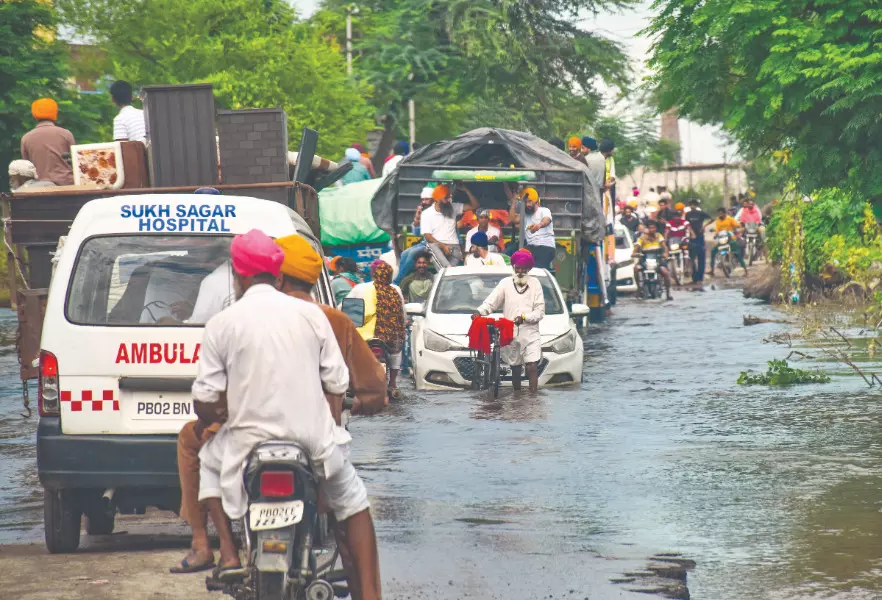Heavy rain, rising rivers and road closures affect millions across North

New Delhi: Heavy rainfall and rising river levels continue to disrupt life across northern and eastern India, as Delhi sees a slight dip in the Yamuna but thousands remain affected, while neighboring Punjab and Haryana face floods and waterlogging that have damaged crops and displaced residents. In Himachal Pradesh, landslides and flash floods have closed over 1,000 roads and forced the evacuation of pilgrims from the Manimahesh Yatra, while Kashmir’s highways remain blocked and schools stay shut for the third consecutive day. Meanwhile, the India Meteorological Department has issued red and orange alerts for Gujarat, Odisha, and Arunachal Pradesh, warning of heavy rains, thunderstorms, and potential flooding, with authorities mobilizing resources to respond to emergencies across all affected regions.
Delhi witnessed a slight easing in the surging Yamuna river on Friday, though numerous areas continued to remain under water. Officials confirmed that the city administration is keeping a round-the-clock watch on the situation, expressing confidence that conditions will return to normal soon. Continued from Page 1
At 6 pm, the water level at the Old Railway Bridge flood forecasting station was recorded at 207.12 metres, following a peak of 207.48 metres a day earlier. Measurements at 5 pm indicated 207.16 metres. Chief Minister Rekha Gupta said, “The situation is likely to return to normal shortly. Nevertheless, the government remains fully engaged in supporting those impacted.”
Gupta conducted an online review meeting with Divisional Commissioner Neeraj Semwal and district magistrates of all 11 revenue districts to assess flood-related challenges. Meanwhile, Public Works Department Minister Parvesh Verma visited key flood-hit areas such as Nigam Bodh Ghat, Monastery Market, and surrounding localities to inspect the situation on the ground. Across the capital, 7,200 people in East Delhi are affected, with seven relief camps set up. North-East Delhi has 5,200 people in 13 camps, South-East Delhi houses 4,200 in eight camps, North Delhi has 1,350 in six camps, and Shahdara district is sheltering 30 individuals in one camp. The Delhi Jal Board (DJB) has cut water production at the Wazirabad Water Treatment Plant by 20 percent due to increased turbidity and silt in the river, leading to water-supply disruptions in some neighborhoods. The Wazirabad plant typically produces 138 million gallons per day.
Floodwater and blocked sewage at Nigam Bodh Ghat have caused significant waterlogging, affecting traffic on Outer Ring Road from Chandgi Ram Akhara to Hanuman Mandir. Authorities have implemented multiple diversions to manage congestion.
Medical teams at relief camps report a rise in cases of fever, rashes, and fungal infections, particularly among children and elderly residents exposed to floodwater. At Sarvodaya Vidyalaya near Kashmere Gate, parents noted recurring fevers and weakness in children under seven. Pooja, a 60-year-old, described her five-year-old grandson suffering from mild fever and rashes, necessitating hospital visits. Authorities have also warned against swimming or recreational activities in the swollen Yamuna.
In neighbouring Punjab, heavy rainfall showed signs of easing, with light showers recorded in Ludhiana (9.8 mm), Patiala (1.8 mm), Gurdaspur (1.7 mm), Faridkot (3.5 mm), and Rupnagar (0.5 mm). Chandigarh received 0.9 mm, while Haryana districts reported Karnal (9 mm), Narnaul (28.5 mm), Rohtak (17.4 mm), and Nuh (2 mm) of rainfall. Floods and waterlogging continue to affect parts of both states.
Punjab’s flood toll reached 43 on Thursday, with 1.71 lakh hectares of crops damaged. Union Agriculture Minister Shivraj Singh Chouhan visited affected districts, describing the scenario as a ‘deluge’ and promising central assistance. Two central assessment teams are evaluating flood impact and will report to the government.
In Himachal Pradesh, the India Air Force evacuated 524 pilgrims stranded on the Manimahesh route, including three deceased, bringing the total airlifted from Bharmour to Chamba since Thursday to 1,166. Seventeen pilgrims have died since the Manimahesh Yatra began on August 15. Chief Minister Sukhvinder Singh Sukhu conducted aerial surveys in Mandi and Kullu, announcing a Rs 3,000 crore relief and reconstruction plan.
The state reported 1,091 road closures due to landslides, flash floods, and heavy rain. Major national highways affected include NH-3, NH-5, NH-305, and NH-505. Monsoon-related incidents in Himachal have claimed at least 360 lives and caused losses estimated at Rs 3,979 crore.
Educational institutions across Kashmir remained closed for a third consecutive day, with classes resuming from Monday after assessing flood damage and ensuring safety. The Jammu-Srinagar national highway remained closed for the fourth day due to landslides, while the inter-regional Mughal Road reopened for vehicular traffic. Over 3,700 vehicles remain stranded along routes from Kathua to Kashmir.
Meanwhile, the Mata Vaishno Devi Yatra continued to be suspended for the 11th day after a landslide on August 26 claimed 34 lives. Authorities are assessing safety and restoration work before resuming the pilgrimage. Local train services connecting Jammu to Katra remained suspended.
In Gujarat, the India Meteorological Department has issued a red warning for heavy rainfall in isolated places over Anand, Bharuch, Botad, and Surendranagar. Residents are advised to take necessary precautions. In Odisha, the IMD has issued an orange alert for heavy rainfall in areas including Kandhamal, Koraput, Malkangiri, Nabarangpur, and Rayagada. The state government is on high alert and has mobilized resources to respond to potential flooding.
In Arunachal Pradesh, the weather department has forecasted thunderstorms and brief showers over the weekend. Authorities are monitoring the situation closely, especially in flood-prone areas.



